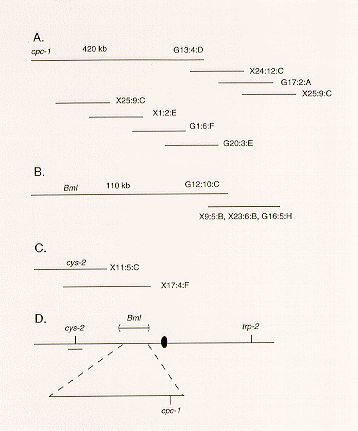Chromosome walking and gene cloning using a Neurospora crassa
Linkage Group VI-specific library.
Thomas J. Schmidhauser - Department of Biology, University of Southwestern Louisiana,
Lafayette, LA
Fungal Genetics Newsletter 46:22
Chromosome walks from the cpc-1 and Bml loci were extended and
the cys-2 locus cloned by sib-selection using a subset of the Orbach/Sachs
Neurospora crassa genomic library.
A 222 clone sub-library of the Orbach/Sachs Neurospora crassa genomic library
was assembled in three microtiter dishes representing cosmids with inserts specific to LGVI
based on preliminary assignment of Neurospora cosmid clones to specific linkage groups by the
University of Georgia Neurospora genome project (J. Arnold, personal communication). A
sub-library adds efficiency to chromosome walking and to sib-selection of genes; in this example
222 clones were blotted for hybridization or prepared for transformation versus 4,800 for the
original library. The LGVI library was used to extend chromosome walks that were initiated to
clone the ylo-1 and vvd loci. The chromosome walks originated at the
cpc-1 locus and the Bml locus and represented approximately 420 kb
and 110 kb, respectively, of Neurospora sequences on LGVIL (Figure 1; Wan et al.
1997 Fungal Genet. Biol. 21:329-336). The cpc-1 and
Bml walks had stopped due to apparent gaps encountered when screening the entire
Orbach/Sachs genomic library. Using our sub-library we were able to identify cosmids
extending the cpc-1 and Bml walks that were not identified in our screen
of the entire Orbach/Sachs library although the filters containing these clones appeared to be in
good condition for hybridization. The LGVI sub-library allowed extension of the
cpc-1 walk, from cosmid G13:4:D, towards the LGVI left telomere by seven "steps".
One new step has been taken from one end of the Bml walk using a cosmid
G12:10:C based probe (Figure 1). No new cosmids have been found to extend the other end of
the Bml walk or of the cpc-1 walk. Several additional overlapping
cosmids were identified in the extension of the cpc-1 walk. The X24:12:C probe
also identified cosmids G8:8:C and G9:1:B, the X25:9:C probe also identified cosmid X9:12:G.
We have not determined the size of the additions to the cpc-1 and Bml
walks.
The LGVI library was divided into 28 primary pools by pooling cosmid DNA representing
one or two rows from each microtiter dish. Each primary pool has from six to twelve cosmid
clones.
Two rounds of transformation into cys-2 spheroplasts identified a
cys-2+ cosmid, X11:5:C. A probe based on X11:5:C identified one
additional cosmid, X17:4:F, which is also cys-2+ (Figure 1). Cloning
of cys-2+ establishes that the walk from the cpc-1 locus
towards the LGVIL telomere has not reached the cys-2 locus (Figure 1).

Figure 1. Chromosome walks on Neurospora LGVI. The figure is not to scale.
(A) Seven steps added to the cpc-1 walk. (B) Three cosmids identified using a G12:10:C probe
from the Bml walk. (C)Two cys-2+ cosmids. (D) Relative locations of the cpc-1 and cys-3 walks on LGVIL.
The location of the Bml walk on LBVIL has not been established with respect to the cpc-1 walk.
Return to the FGN 46 Table of Contents
Return to the FGSC main page
